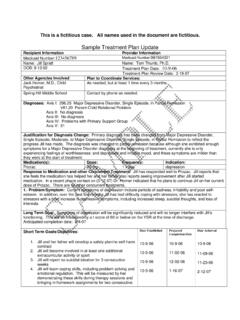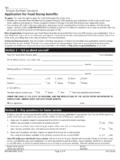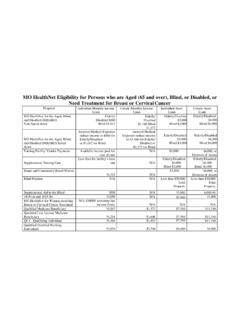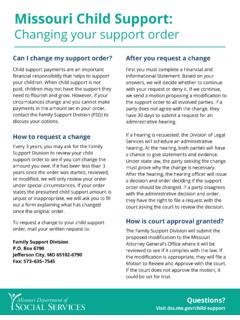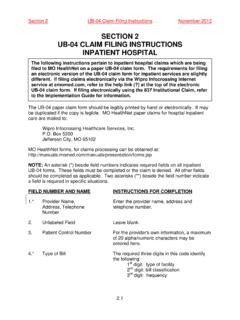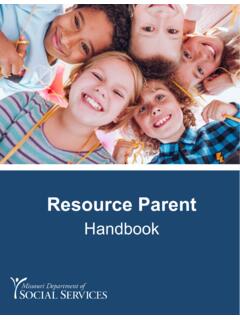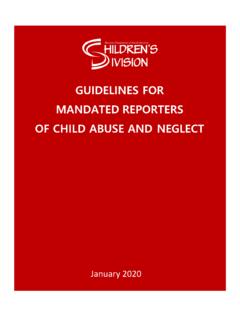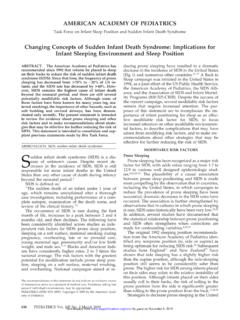Transcription of SIDS and Safe Sleep - Missouri Department of Social Services
1 Missouri Department of Social Services , Missouri State Technical Assistance Team PO Box 208 Jefferson City, MO 65102-0208 (573) 751-5980 or Toll Free at (800) 487-1626 What You May Not Know About sids and safe Sleep The Problem xEach year in the United States, more than 4,500 infants die suddenly of no obvious cause. Half of these deaths are diagnosed as sudden infant death syndrome ( sids ). xSIDS is the sudden death of an infant under 1 year of age, which remains unexplained after a thorough case investigation, including the performance of a complete autopsy, examination of the death scene and review of the clinical history (Willinger et al., 1991).
2 XIn 2007, there were 127 sudden , unexpected deaths of infants under the age of one year reported to the Missouri Child Fatality Review Program (CFRP). xOf the 127 infant deaths (based on autopsy, investigation and CFRP panel review), 15 were diagnosed as sudden infant death syndrome ( sids ), 59 Unintentional Suffocation, 25 Illness/Natural Cause, and 23 could not be determined, but had questionable circumstances. xFour infants were found to be victims of Homicide and one infant s death was determined to be an accident, resulting from exposure to excessive heat. Risk Factors for sids Tummy (prone) or side sleeping Bed sharing Soft bedding and/or loose bedding Baby being exposed to smoking Preterm and low birth weight infants Unintentional Suffocation In addition to sids , infants can die from unintentional suffocation.
3 Most infant deaths, due to suffocation, are directly related to an unsafe Sleep environment. Infants can suffocate when their faces become positioned against or buried in a mattress, cushion, wedge, pillow, comforter or bumper pad. They can also suffocate if their faces, noses, or mouths are covered by soft bedding, such as pillows, quilts, comforters and sheepskins. An overlay is a type of unintentional suffocation. This occurs when an infant is sleeping with one or more persons (bed sharing), and someone rolls over on them. Prevent sids by Providing a safe Sleep Environment Infants should ALWAYS be placed on their backs (face up) when they are resting, sleeping or left alone.
4 Infants should be placed on their tummies ONLY when they are awake and supervised by someone responsible. Supervised tummy time is encouraged to help make an infant s neck and back muscles strong. When infants are sleeping or napping, they should only be placed in cribs approved by the Consumer Product Safety Commission (CPSC). If a crib is not available, an infant should be placed on another safe , firm Sleep surface such as a bassinet or cradle that does not have fluffy or soft items on its Sleep surface. Infants should always be placed on a firm surface or mattress. Infants should be dressed in a sleeper or warm pajamas instead of covering the infant with a blanket.
5 If an infant is covered with a blanket, make sure the blanket stays at or lower than the infant s waist. Parents or caregivers who want to be close to their infant while they are sleeping, can move the crib or bassinet next to their bed. Infants should not be placed to Sleep on sofas, couches, pillows or waterbeds. Infants should not be placed to Sleep with stuffed toys, pillows, bumper pads, quilts or comforters. (Centers for Disease Control and Prevention) Missouri Department of Social Services , Missouri State Technical Assistance Team PO Box 208 Jefferson City, MO 65102-0208 (573) 751-5980 or Toll Free at (800) 487-1626 Separate Sleeping Environments xThe American Academy of Pediatrics recommends a separate, but approximate, sleeping environment for the infant .
6 XThere is growing evidence that room sharing ( infant sleeping in a crib in parent s bedroom) is associated with a reduced risk of sids . Additional safe Sleep Environment Tips from the American Academy of Pediatrics: xPlace the crib in an area that is always smoke free. xAvoid letting the baby get too hot. Dress the baby lightly for Sleep and set the room temperature in a range that is comfortable for a lightly clothed adult. xBreastfeed your baby. Experts recommend that mothers feed their children human milk at least through the first year of life. (American Academy of Pediatrics) Using Fans to Prevent sids In October 2008, a new study was released from Archives of Pediatrics & Adolescent Medicine.
7 The study included interviews with the mothers of 185 infants who died from sids , and the mothers of 312 other babies. According to the study, fans in a baby s room may help prevent sids . Fans offered even more protection to babies sleeping in warm rooms. According to the study, babies who slept with a fan in their room, reduced their chances of dying from sids by 72 percent. Researchers think fans may help to circulate fresh air and prevent babies from suffocating by re-breathing exhaled carbon dioxide, one of the culprits many doctors feel causes sids . The safe Crib Project in Missouri This project provides a new, safe crib to families in need, along with parent education about safe Sleep arrangements for infants.
8 In communities throughout Missouri , Social service agencies, community health agencies, hospitals and other organizations have collaborated to implement the safe Crib Project, using funding from the Missouri Children s Trust Fund. The goal of the safe Crib Project is to save infant lives and support families. For more information about active safe Crib Projects or funding opportunities, please contact the Children s Trust Fund at 573-751-5147 or visit For more information on sids and safe Sleep Environments, visit these websites: xAmerican Academy of Pediatrics (Healthy Child Care America Back to Sleep Campaign), xCenters for Disease Control and Prevention, xFirst Candle, xMissouri Department of Health and Senior Services , xNational sids / infant death Resource Center, xNational Institute of Child Health and Human Development, xSIDS Resources, Inc.
9 , xSt. Louis safe Sleep Task Force.
